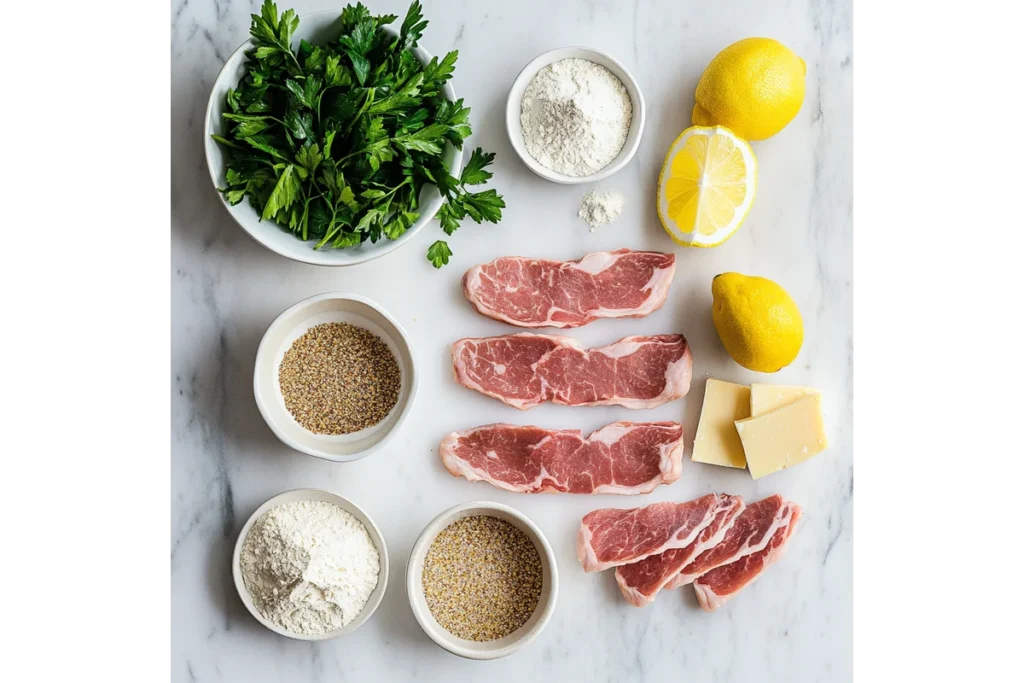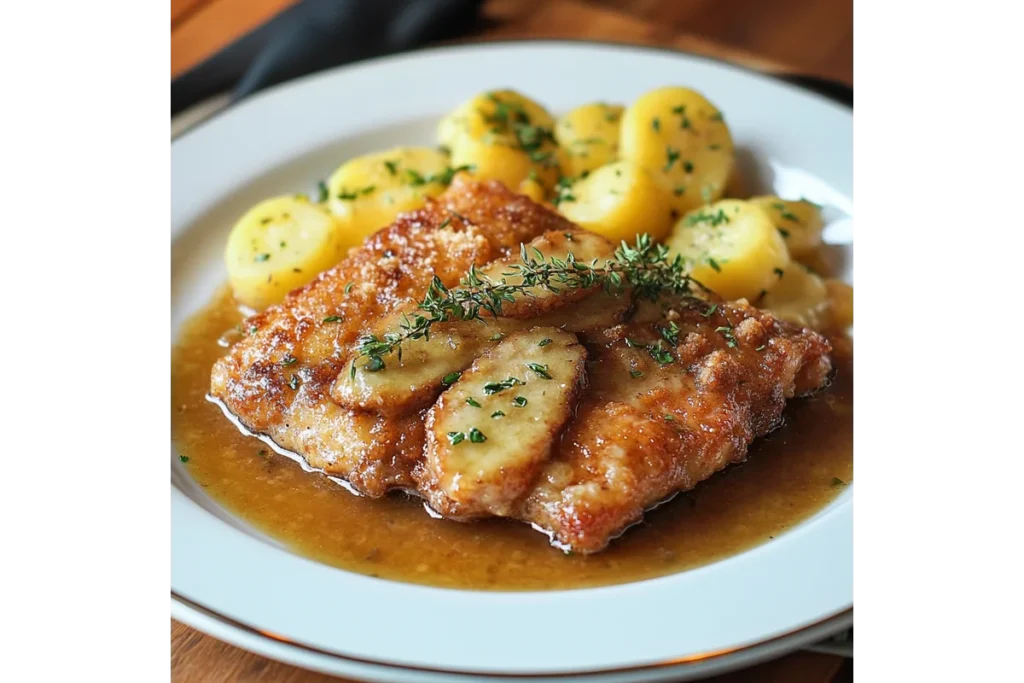Before we dive into the nitty-gritty, let me tell you—this cachopo recipe is a game-changer. If you’ve never heard of cachopo (pronounced kah-CHO-po), don’t sweat it! By the end of this guide, you’ll not only know what it is but also how to whip up an authentic version that’ll have your friends and family raving. We’re talking about a hearty, breaded meat dish from Spain’s Asturias region, packed with gooey cheese and savory ham. Sounds good, right? Well, buckle up because we’re about to take you through everything you need to know—from ingredients to serving tips. Let’s get started!
Introduction to Cachopo – A Spanish Culinary Delight
What is Cachopo?
So, what exactly is cachopo, you ask? Imagine a giant, flattened piece of beef or veal stuffed with layers of ham and cheese, then breaded and fried until golden brown. It’s kind of like a supersized chicken cordon bleu, but way more indulgent. Originating in Asturias, a lush region in northern Spain, cachopo has become a beloved staple of Spanish cuisine. You’ll often find it served in local taverns alongside roasted potatoes or a fresh salad. Honestly, one bite of this crispy, cheesy goodness, and you’ll understand why it’s such a hit.
The history of cachopo is as rich as its flavor. While no one knows for sure when it first popped up, most food historians agree it’s been around for decades. Locals swear by its comforting taste, especially during chilly winter months when hearty meals are a must.
Why You Should Try Making Cachopo at Home
Now, here’s the kicker—you don’t need to hop on a plane to Spain to enjoy cachopo. With this cachopo recipe , you can recreate the magic in your own kitchen. Trust me, there’s something incredibly satisfying about making a dish that feels both fancy and homey at the same time. Plus, it’s a great way to impress dinner guests without breaking a sweat.
What makes cachopo stand out is its versatility. Whether you’re a meat lover or leaning toward plant-based options, there’s room for everyone at the cachopo table. And hey, who doesn’t love a dish that combines crispy breading, melty cheese, and savory ham all in one bite?
Why This Cachopo Recipe Stands Out
Let’s face it—not all recipes are created equal. This cachopo recipe focuses on simplicity and authenticity, so you won’t need any crazy tools or hard-to-find ingredients. Just follow along, and you’ll be churning out restaurant-quality cachopo in no time.
Table of Contents
Ingredients Needed for an Authentic Cachopo Recipe
Essential Ingredients for Cachopo
Alright, let’s talk ingredients because, honestly, the magic of any cachopo recipe starts here. First up, you’ll need some quality meat—beef or veal cutlets are traditional choices. The key is to pick something thin enough to flatten but sturdy enough to hold the filling. If you’re not sure where to find veal, don’t stress; beef works just fine and is often easier to get your hands on.
Next, you’ll want to grab some ham and cheese for the filling. Serrano ham is a classic choice, but if you can’t find it, prosciutto or even good ol’ smoked ham will do the trick. As for cheese, Manchego is the go-to, but feel free to swap it out for something like Gouda or Swiss if that’s what you’ve got. After all, cooking should be fun—not stressful!
By the way, this is also where you can get creative. Want to add a little spice? Throw in some pepper jack cheese. Craving extra flavor? A sprinkle of herbs like thyme or oregano inside the layers never hurts.
Breading Components

Now, onto the breading part. For that perfectly crispy crust, you’ll need three things: flour, eggs, and breadcrumbs. Here’s how it works—you’ll coat the meat in flour first, then dip it in beaten eggs, and finally roll it in breadcrumbs. Simple, right? But wait, there’s a pro tip here: use panko breadcrumbs instead of regular ones. They give the cachopo an extra crunch that’s absolutely irresistible.
If you’re feeling adventurous, toss some garlic powder or paprika into the breadcrumb mix. These small tweaks can take your cachopo recipe from “good” to “wow, I need seconds!”
Substitutions and Variations
Not everyone eats meat, and that’s totally okay! There are plenty of ways to adapt this cachopo recipe for different diets. For vegetarians, try using portobello mushrooms or eggplant slices as the base. Vegans can swap out the cheese and eggs for plant-based alternatives like cashew cheese and flaxseed “egg” washes.
Gluten-free folks aren’t left out either. Just switch the regular breadcrumbs for gluten-free ones, and you’re good to go. Honestly, the beauty of cachopo lies in its flexibility. No matter your dietary needs, there’s a way to make it work.
Choosing High-Quality Ingredients for Your Cachopo Recipe
Let’s not forget—the better the ingredients, the better the dish. So, splurge a little on fresh produce and high-quality proteins. Trust me, your taste buds will thank you later.
Step-by-Step Instructions for Preparing Cachopo
Preparing the Meat Base
Before we dive into the assembly line, let’s prep the star of the show—the meat. Start by laying your beef or veal cutlets flat on a cutting board. Grab a meat mallet (or even a rolling pin if you’re improvising) and gently pound them until they’re about ¼ inch thick. This step is crucial because thinner meat cooks faster and holds the filling better.
Here’s a quick tip: place the cutlets between two sheets of plastic wrap before pounding. That way, you won’t end up with bits of meat flying across the kitchen—who needs that mess? Once they’re flattened, season both sides lightly with salt and pepper.
Assembling the Filling
Now comes the fun part—layering the goodies! Take a slice of ham and lay it over one half of each cutlet. Follow that up with a generous handful of cheese. Don’t skimp here; the melty goodness is what makes cachopo so darn tasty. Fold the other half of the meat over the filling to create a sandwich-like structure.
To keep everything in place, secure the edges with toothpicks or tie them with kitchen twine. Sure, it might seem fussy, but trust me—it prevents the filling from leaking out during frying. And nobody wants a soggy cachopo, am I right?
The Breading Process

Okay, time to bread this bad boy. Set up a mini assembly line with three shallow bowls: one for flour, one for beaten eggs, and one for breadcrumbs. Dredge each stuffed cutlet in flour first, shaking off any excess. Then dip it into the egg wash, making sure it’s fully coated. Finally, roll it in the breadcrumbs, pressing gently to help them stick.
Pro tip: double-dip the cutlets in the egg and breadcrumbs for an extra-thick crust. It’s a bit more effort, but oh-so-worth-it when you bite into that golden crunch.
Cooking Techniques for Perfect Results
When it comes to cooking cachopo, you’ve got options. Pan-frying is the classic method—just heat some oil in a skillet over medium-high heat and cook each side for about 3-4 minutes until golden brown. Alternatively, baking is a healthier route. Pop the breaded cutlets on a lined baking sheet at 400°F for around 15-20 minutes, flipping halfway through.
Whichever method you choose, let the cachopo rest for a few minutes before slicing into it. This gives the cheese time to settle and prevents molten lava-like burns.
Mastering the Art of Cooking Cachopo Like a Pro
With these steps under your belt, you’re well on your way to nailing this cachopo recipe . Next up, we’ll cover serving suggestions and pairings to round out your meal. Stay tuned!
Serving Suggestions and Pairings for Cachopo
Classic Side Dishes to Serve with Cachopo
Alright, so you’ve nailed the cachopo recipe —now what? Let’s talk about how to round out the meal because, let’s be honest, no dish is complete without some killer sides. In Asturias, where cachopo hails from, it’s often served with roasted potatoes or a simple green salad. The starchy, earthy flavors of the potatoes balance out the richness of the meat, while the salad adds a refreshing crunch.
If you’re feeling fancy, whip up some patatas bravas (fried potatoes with spicy tomato sauce) or even a side of fabada, a hearty Asturian bean stew. These pairings are traditional and pack a punch of flavor that complements the dish beautifully.
Wine Pairings for Cachopo
Now, onto beverages! A glass of red wine is practically mandatory when serving cachopo. Rioja or Mencia wines are excellent choices because their bold, fruity notes stand up well to the dish’s savory filling. If you’re not into wine, no worries—sparkling water with a squeeze of lemon or a cold beer works just as well.
For non-drinkers, consider whipping up a homemade sangria or a refreshing citrus spritzer. Honestly, the goal here is to keep things light and enjoyable.
Presentation Tips for Impressive Plating

Presentation matters, folks! To make your cachopo look as good as it tastes, slice it diagonally before plating. This shows off the gooey cheese and ham layers inside. Garnish with fresh parsley or a sprinkle of paprika for a pop of color. Serve it on a rustic wooden board or a warm plate to give it that cozy, home-cooked vibe.
Common Mistakes to Avoid When Making Cachopo
Overfilling the Meat Layers
One rookie mistake people make with their cachopo recipe is overstuffing the filling. Sure, it’s tempting to pile on the ham and cheese, but too much can cause the layers to burst during cooking. Stick to a moderate amount—you want every bite to be balanced, not overwhelmingly cheesy.
Skipping Resting Time Before Cooking
Another big no-no? Skipping the resting step. After assembling your cachopo, let it chill in the fridge for at least 15-20 minutes. This firms up the filling and makes frying easier. Trust me, patience pays off here.
Undercooking or Overcooking
Timing is everything when it comes to frying or baking cachopo. Undercook it, and you risk soggy breading; overcook it, and the meat turns tough. Aim for a golden-brown crust and an internal temperature of 160°F for beef or veal. Use a meat thermometer if you’re unsure—it’s a lifesaver.
Avoid These Pitfalls for a Flawless Cachopo Recipe
By steering clear of these common mistakes, you’ll ensure your cachopo turns out perfectly every time. Up next, we’ll answer some FAQs to clear up any lingering questions you might have. Stay tuned!
FAQs :
Is cachopo healthy?
Cachopo is a hearty, indulgent dish, but its healthiness depends on how it’s prepared. Traditional recipes involve frying breaded meat, which can be high in calories and fat. However, you can make healthier versions by baking instead of frying or using leaner cuts of meat. Adding plenty of vegetables as sides—like roasted veggies or a fresh salad—can also balance the meal. While it’s not exactly “light,” enjoying cachopo in moderation as part of a balanced diet is perfectly fine!
What is cachopo used for?
Cachopo is primarily used as a main course in Spanish cuisine, especially in Asturias, where it originated. It’s a show-stopping dish often served during family gatherings, celebrations, or special occasions due to its rich flavors and impressive presentation. Beyond that, cachopo is a fantastic way to introduce people to Asturian culture and culinary traditions. Whether you’re cooking for friends or simply craving comfort food, cachopo fits the bill beautifully.
What to serve with cachopo?
Cachopo pairs wonderfully with simple, hearty sides that complement its richness. Classic options include roasted potatoes, French fries, or a crisp green salad. For a more traditional touch, serve it alongside fabada (a bean stew) or patatas bravas (fried potatoes with spicy tomato sauce). To drink, pair it with red wine like Rioja or Mencia, or opt for sparkling water with lemon for a refreshing non-alcoholic choice. Garnishing with fresh parsley adds a pop of color and freshness to the plate.
What is cachopo in English?
In English, cachopo is often described as a “stuffed and breaded meat cutlet.” It’s similar to dishes like chicken cordon bleu but uses beef or veal instead of chicken. The name itself doesn’t have a direct translation, but its concept is easy to understand: thin slices of meat stuffed with ham and cheese, coated in breadcrumbs, and fried until crispy. Think of it as a supersized, Spanish-inspired schnitzel with gooey layers inside!
Conclusion
Recap of Key Points
Let’s take a quick look back at what we’ve covered. Cachopo is more than just a dish—it’s a celebration of flavor, texture, and tradition. With this cachopo recipe , you’ve learned how to flatten the meat, layer the filling, and achieve that golden-brown crunch everyone loves. Plus, we’ve shared tips for pairing, plating, and avoiding common mistakes.
Encouragement to Experiment
Here’s the thing—cooking should be fun. So don’t be afraid to put your own spin on this classic dish. Swap ingredients, try new sides, or even host a “cachopo night” with friends. Who knows? You might just create your own signature version.
Final Thoughts on Crafting the Best Cachopo Recipe
At the end of the day, cachopo is all about bringing people together over good food. Whether you’re whipping it up for a special occasion or just craving something indulgent, this dish has got you covered.
For more delicious recipes and kitchen inspiration, stick around and explore our other articles.
Print
Cachopo Recipe: How to Make the Perfect Spanish Dish
- Total Time: 35 minutes (baking) / 28 minutes (frying)
- Yield: 4 serving 1x
Description
Discover how to make an authentic cachopo recipe , a mouthwatering Spanish dish featuring breaded beef or veal stuffed with ham and cheese. This hearty, indulgent meal is perfect for special occasions or when you’re craving something comforting yet impressive. Follow our step-by-step guide to create this golden-brown masterpiece in your own kitchen!
Ingredients
For the Cachopo:
- 4 thin beef or veal cutlets (about ¼ inch thick)
- 4 slices of Serrano ham (or prosciutto)
- 4 slices of Manchego cheese (or Gouda/Swiss)
- Salt and pepper (to taste)
For the Breading:
- 1 cup all-purpose flour
- 2 large eggs (beaten)
- 1½ cups breadcrumbs (preferably panko for extra crunch)
- Optional: garlic powder, paprika, or dried herbs for seasoning
For Cooking:
- Vegetable oil (for frying) or olive oil spray (for baking)
Serving Suggestions:
- Roasted potatoes, green salad, or patatas bravas
- Red wine like Rioja or Mencia
Instructions
Prepare the Meat Base:
- Lay the beef or veal cutlets flat on a cutting board. Place them between two sheets of plastic wrap and gently pound with a meat mallet until they’re about ¼ inch thick. Season both sides lightly with salt and pepper.
Assemble the Filling:
- Place a slice of ham and cheese on one half of each cutlet. Fold the other half over the filling to create a sandwich-like structure. Secure the edges with toothpicks or kitchen twine to prevent the filling from leaking out during cooking.
Bread the Cachopo:
- Set up a breading station with three shallow bowls: one for flour, one for beaten eggs, and one for breadcrumbs. Dredge each stuffed cutlet in flour, shaking off excess. Dip it into the egg wash, then roll it in breadcrumbs, pressing gently to ensure an even coating. For an extra-thick crust, double-dip in the egg and breadcrumbs.
Cook the Cachopo:
- Pan-Frying Method: Heat vegetable oil in a skillet over medium-high heat. Fry each cachopo for 3-4 minutes per side until golden brown and crispy. Drain on paper towels.
- Baking Method: Preheat the oven to 400°F (200°C). Place the breaded cutlets on a lined baking sheet and bake for 15-20 minutes, flipping halfway through, until golden and cooked through.
Rest and Serve:
- Let the cachopo rest for 5 minutes before slicing into it. Garnish with fresh parsley and serve alongside roasted potatoes, a green salad, or your choice of sides.
Notes
- For a vegetarian version, use portobello mushrooms or eggplant slices instead of meat.
- Gluten-free? Swap regular breadcrumbs for gluten-free ones.
- Double-check the internal temperature of the meat—it should reach at least 160°F (71°C) for beef or veal.
- Prep Time: 20 min
- Cook Time: 15 minutes (baking) / 8 minutes (frying)
- Category: Main Course
- Method: Pan-frying or Baking
- Cuisine: Spanish
Nutrition
- Serving Size: 1 cachopo
- Calories: 450 kcal
- Sugar: 2 g
- Sodium: 600 mg
- Fat: 22 g
- Saturated Fat: 8 g
- Unsaturated Fat: 12 g
- Trans Fat: 0 g
- Carbohydrates: 30 g
- Fiber: 2 g
- Protein: 35 g
- Cholesterol: 150 mg
Keywords: Cachopo recipe, Spanish stuffed steak, breaded meat dish, Asturian cuisine, cheesy beef cutlet

